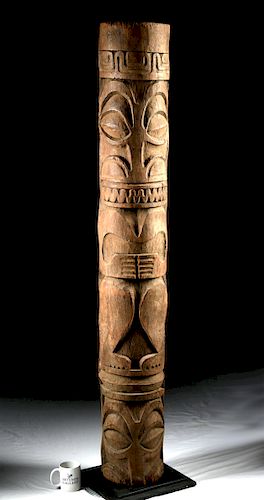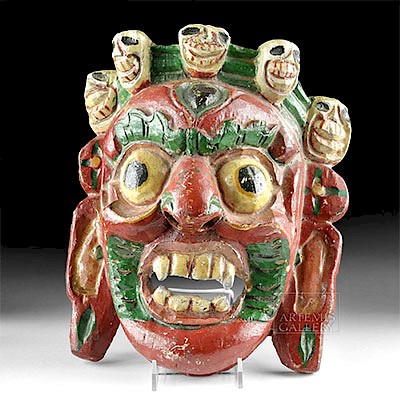Massive 19th C. Marquesas Island Wood Tiki Figure
Lot 161a
About Seller
Artemis Fine Arts
686 S Taylor Ave, Ste 106
Louisville, CO 80027
United States
Selling antiquities, ancient and ethnographic art online since 1993, Artemis Gallery specializes in Classical Antiquities (Egyptian, Greek, Roman, Near Eastern), Asian, Pre-Columbian, African / Tribal / Oceanographic art. Our extensive inventory includes pottery, stone, metal, wood, glass and textil...Read more
Estimate:
$12,000 - $18,000
Absentee vs Live bid
Two ways to bid:
- Leave a max absentee bid and the platform will bid on your behalf up to your maximum bid during the live auction.
- Bid live during the auction and your bids will be submitted real-time to the auctioneer.
Bid Increments
| Price | Bid Increment |
|---|---|
| $0 | $25 |
| $300 | $50 |
| $1,000 | $100 |
| $2,000 | $250 |
| $5,000 | $500 |
| $10,000 | $1,000 |
| $20,000 | $2,500 |
| $50,000 | $5,000 |
| $100,000 | $10,000 |
| $200,000 | $20,000 |
About Auction
By Artemis Fine Arts
Apr 25, 2019
Set Reminder
2019-04-25 10:00:00
2019-04-25 10:00:00
America/New_York
Bidsquare
Bidsquare : Pre-Columbian | Tribal | Ethnographic
https://www.bidsquare.com/auctions/artemis-gallery/pre-columbian-tribal-ethnographic-4035
Featuring ancient and ethnographic art from around the world, including Pre-Columbian, Native American, African / Tribal, Ethnographic, Spanish Colonial, Fossils, Fine Art, much more. Artemis Fine Arts info@artemisfinearts.com
Featuring ancient and ethnographic art from around the world, including Pre-Columbian, Native American, African / Tribal, Ethnographic, Spanish Colonial, Fossils, Fine Art, much more. Artemis Fine Arts info@artemisfinearts.com
- Lot Description
Oceania, Marquesas Islands (French Polynesia), ca. 19th century CE. A massive wooden tiki figure, depicting a stylized ancestor figure standing atop a disembodied head, all carved in bas relief on one side of a tall, round post. The other side is smooth. The eyes of the ancestor are at standing height and draw in the viewer, outlined by arched brows, with large nostrils below reminiscent of a frog's. Above the head is a line of simple geometric carvings like a headdress or possibly elaborate coiffure. The mouth is a wide, horizontal line, full of teeth and with thin lips. The body below that is zoomorphic, with hands clasped at the center and the legs bent into a crouch. Below the feet is another head of similar form to the upper one, but with a simple, linear headdress/coiffure. Size: 9.5" W x 66.75" H (24.1 cm x 169.5 cm); 68" H (172.7 cm) on included custom stand.
Tiki figures originated in the Marquesas, and spread throughout most of Polynesia, often with local twists (for example, the moai of Easter Island are believed to be a form of tiki). They represent the ancestor Ti'i who is half human, half god and represents the first man. He is often shown with his hands on his stomach and his legs crouched, as here. His head is large to emphasize his power; his big eyes represent his great knowledge. Most tiki figures are carved from volcanic stone; wood examples are rarer, especially one this large. The island of Ua Huka is particularly famous for wooden carvings, most of which are made from miro (Oceania rosewood), tou (Oceania walnut), aito (iron wood), and the coconut tree. Tiki statues like this one were placed outside of houses, made to protect the inhabitants. In the southern Marquesas and Ua Huka (which is geographically closer to the north but culturally similar to the south), the term me'ae was used to describe a sacred place; these were often located just outside of villages and surrounded by palisades, with a house with protective, lifesize wooden tiki located in the center. These buildings served as shrines for the village. A tiki like this one may have protected such a place in the past.
Provenance: private Hawaii, USA collection; ex-old Hawaii, USA collection
All items legal to buy/sell under U.S. Statute covering cultural patrimony Code 2600, CHAPTER 14, and are guaranteed to be as described or your money back.
A Certificate of Authenticity will accompany all winning bids.
We ship worldwide and handle all shipping in-house for your convenience.
#143592Small losses from base and top, with other light surface wear commensurate with age including small chips, nicks, and scratches. The wood has dried and developed thin cracks along many of its grains, but none of these is threatening the integrity of the piece. Small areas, mainly on the uncarved back, of old paint. Rich, dark patina on surface with excellent preserved details.Condition
- Shipping Info
-
All shipping is handled in-house for your convenience. Your invoice from Artemis Gallery will include shipping calculation instructions. If in doubt, please inquire BEFORE bidding for estimated shipping costs for individual items.
-
- Buyer's Premium



 EUR
EUR CAD
CAD AUD
AUD GBP
GBP MXN
MXN HKD
HKD CNY
CNY MYR
MYR SEK
SEK SGD
SGD CHF
CHF THB
THB















